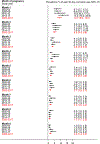Cannabis use among women of reproductive age in the United States: 2002-2017
- PMID: 31421581
- PMCID: PMC6791768
- DOI: 10.1016/j.addbeh.2019.106082
Cannabis use among women of reproductive age in the United States: 2002-2017
Abstract
Background: In this study of cannabis use in large nationally representative samples of United States (US) women aged 12-44 years, we evaluate variation by pregnancy month and by trimester. We also evaluate cannabis dependence, which might explain why some women continue using cannabis during pregnancy.
Methods: Large nationally representative samples drawn for the US National Surveys on Drug Use and Health included 12-44-year-old women asked about pregnancy month, cannabis use, and cannabis dependence (n = 381,199). For this research, we produced month-specific estimates across four-time intervals (2002-2005, 2006-2009, 2010-2013, 2014-2017).
Results: Overall from 2002 to 2017, estimates for non-pregnant women and for pregnant women in Trimester 1 indicate 7%-8% had used cannabis at least once in the 30 days prior to assessment. For pregnancy Month 1, the corresponding estimate is 11%, double Month 3 estimate of 5%. This degree of month-to-month variation is not seen for pregnant women in Trimesters 2 and 3, for whom estimates are 3% and 2%, respectively. Among women using cannabis during pregnancy, an estimated 19% have cannabis dependence, versus an expected value of 13% among non-pregnant women (p < .05).
Conclusion: Evidence of a possibly ameliorative pregnancy-associated reduction of cannabis use prevalence was seen by Month 3 during pregnancy. Cannabis dependence may help account for cannabis use early during pregnancy. Identification and outreach to reproductive age women with cannabis dependence might decrease prenatal cannabis exposure.
Keywords: Cannabis; Dependence; Marijuana; NSDUH; Pregnancy; Women.
Copyright © 2019 Elsevier Ltd. All rights reserved.
Conflict of interest statement
Conflict of Interest
Both authors declare that they have no conflicts of interest.
Figures




References
-
- American Psychiatric Association, T. F. o. D.-I. (1994). Diagnostic and statistical manual of mental disorders: DSM-IV: Amer Psychiatric Pub Inc.
-
- Ayoola AB, Nettleman MD, Stommel M, & Canady RB (2010). Time of pregnancy recognition and prenatal care use: a population-based study in the United States. Birth, 37(1), 37–43. - PubMed
Publication types
MeSH terms
Grants and funding
LinkOut - more resources
Full Text Sources
Medical

